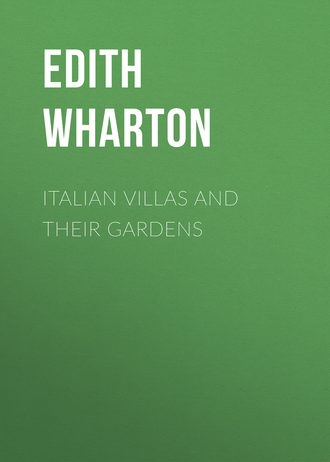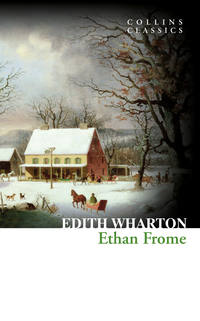 полная версия
полная версияItalian Villas and Their Gardens
Poggio Imperiale was for too long the favourite residence of the grand-ducal Medici, and of their successors of Lorraine, not to suffer many changes, and to lose, one by one, all its most typical features. Within there is a fine court surrounded by an open arcade, probably due to Giulio Parigi, who, at the end of the sixteenth century, completed the alterations of the villa according to the plans of Giuliano da Sangallo; and the vast suites of rooms are interesting to the student of decoration, since they are adorned, probably by French artists, with exquisite carvings and stucchi of the Louis XV and Louis XVI periods. But the grounds have kept little besides their general plan. At the back, the villa opens directly on a large level pleasure-garden, with enclosing walls and a central basin surrounded by statues; but the geometrical parterres have been turned into a lawn. To the right of this level space, a few steps lead down to a long terrace planted with ilexes, whence there is a fine view over Florence—an unusual arrangement, as the bosco was generally above, not below, the flower-garden.
If, owing to circumstances, the more famous pleasure-grounds of Florence have lost much of their antique charm, she has happily preserved a garden of another sort which possesses to an unusual degree the flavour of the past. This is the villa of the Gamberaia at Settignano. Till its recent purchase, the Gamberaia had for many years been let out in lodgings for the summer, and it doubtless owes to this obscure fate the complete preservation of its garden-plan. Before the recent alterations made in its gardens, it was doubly interesting from its unchanged condition, and from the fact that, even in Italy, where small and irregular pieces of ground were so often utilized with marvellous skill, it was probably the most perfect example of the art of producing a great effect on a small scale.
The villa stands nobly on a ridge overlooking the village of Settignano and the wide-spread valley of the Arno. The house is small yet impressive. Though presumably built as late as 1610, it shows few concessions to the baroque style already prevalent in other parts of Italy, and is yet equally removed from the classic or Palladian manner which held its own so long in the Venetian country. The Gamberaia is distinctly Tuscan, and its projecting eaves, heavily coigned angles and windows set far apart on massive consoles, show its direct descent from the severe and sober school of sixteenth-century architects who produced such noble examples of the great Tuscan villa as I Collazzi and Fonte all’ Erta. Nevertheless, so well proportioned is its elevation that there is no sense of heaviness, and the solidity of the main building is relieved by a kind of flying arcade at each end, one of which connects the house with its chapel, while the other, by means of a spiral stairway in a pier of the arcade, leads from the first floor to what was once the old fish-pond and herb-garden. This garden, an oblong piece of ground, a few years ago had in its centre a round fish-pond, surrounded by symmetrical plots planted with roses and vegetables, and in general design had probably been little changed since the construction of the villa. It has now been remodelled on an elaborate plan, which has the disadvantage of being unrelated in style to its surroundings; but fortunately no other change has been made in the plan and planting of the grounds.
Before the façade of the house a grassy terrace bounded by a low wall, set alternately with stone vases and solemn-looking stone dogs, overhangs the vineyards and fields, which, as in all unaltered Tuscan country places, come up close to the house. Behind the villa, and running parallel with it, is a long grass alley or bowling-green, flanked for part of its length by a lofty retaining-wall set with statues, and for the remainder by high hedges which divide it on one side from the fish-pond garden and on the other from the farm. The green is closed at one end by a grotto of coloured pebbles and shells, with nymphs and shepherds in niches about a fountain. This grotto is overhung by the grove of ancient cypresses for which the Gamberaia is noted. At its opposite end the bowling-green terminates in a balustrade whence one looks down on the Arno and across to the hills on the southern side of the valley.
The retaining-wall which runs parallel with the back of the house sustains a terrace planted with cypress and ilex. This terraced wood above the house is very typical of Italian gardens: good examples may be seen at Castello and at the Villa Medici in Rome. These patches of shade, however small, are planted irregularly, like a wild wood, with stone seats under the dense ilex boughs, and a statue placed here and there in a deep niche of foliage. Just opposite the central doorway of the house the retaining-wall is broken, and an iron gate leads to a slit of a garden, hardly more than twenty feet wide, on a level with the bowling-green. This narrow strip ends also in a grotto-like fountain with statues, and on each side balustraded flights of steps lead to the upper level oh which the ilex-grove is planted. This grove, however, occupies only one portion of the terrace. On the other side of the cleft formed by the little grotto-garden, the corresponding terrace, formerly laid out as a vegetable-garden, is backed by the low façade of the lemon-house, or stanzone, which is an adjunct of every Italian villa. Here the lemon and orange trees, the camellias and other semi-tender shrubs, are stored in winter, to be set out in May in their red earthen jars on the stone slabs which border the walks of all old Italian gardens.
The plan of the Gamberaia has been described thus in detail because it combines in an astonishingly small space, yet without the least sense of overcrowding, almost every typical excellence of the old Italian garden: free circulation of sunlight and air about the house; abundance of water; easy access to dense shade; sheltered walks with different points of view; variety of effect produced by the skilful use of different levels; and, finally, breadth and simplicity of composition.
Here, also, may be noted in its fullest expression that principle of old gardening which the modern “landscapist” has most completely unlearned, namely, the value of subdivision of spaces. Whereas the modern gardener’s one idea of producing an effect of space is to annihilate his boundaries, and not only to merge into one another the necessary divisions of the garden, but also to blend this vague whole with the landscape, the old garden-architect proceeded on the opposite principle, arguing that, as the garden is but the prolongation of the house, and as a house containing a single huge room would be less interesting and less serviceable than one divided according to the varied requirements of its inmates, so a garden which is merely one huge outdoor room is also less interesting and less serviceable than one which has its logical divisions. Utility was doubtless not the only consideration which produced this careful portioning off of the garden. Æsthetic impressions were considered, and the effect of passing from the sunny fruit-garden to the dense grove, thence to the wide-reaching view, and again to the sheltered privacy of the pleached walk or the mossy coolness of the grotto—all this was taken into account by a race of artists who studied the contrast of æsthetic emotions as keenly as they did the juxtaposition of dark cypress and pale lemon-tree, of deep shade and level sunlight. But the real value of the old Italian garden-plan is that logic and beauty meet in it, as they should in all sound architectural work. Each quarter of the garden was placed where convenience required, and was made accessible from all the others by the most direct and rational means; and from this intelligent method of planning the most varying effects of unexpectedness and beauty were obtained.
It was said above that lawns are unsuited to the Italian soil and climate, but it must not be thought that the Italian gardeners did not appreciate the value of turf. They used it, but sparingly, knowing that it required great care and was not a characteristic of the soil. The bowling-green of the Gamberaia shows how well the beauty of a long stretch of greensward was understood; and at the Villa Capponi, at Arcetri, on the other side of Florence, there is a fine oblong of old turf adjoining the house, said to be the only surviving fragment of the original garden. These bits of sward were always used near the house, where their full value could be enjoyed, and were set like jewels in clipped hedges or statue-crowned walls. Though doubtless intended chiefly for games, they were certainly valued for their æsthetic effect, for in many Italian gardens steep grass alleys flanked by walls of beech or ilex are seen ascending a hillside to the temple or statue which forms the crowning ornament of the grounds. In Florence a good example of this tapis vert, of which Le Nôtre afterward made such admirable use in the moist climate of France, is seen at the Villa Danti, on the Arno near Campiobbi.
Close to the ducal villas of Castello lies a country-seat possessing much of the intimate charm which they lack. This is Prince Corsini’s villa, the finest example of a baroque country house near Florence. The old villa, of which the typical Tuscan elevation may still be seen at the back, was remodelled during the latter half of the seventeenth century, probably by Antonio Ferri, who built the state saloon and staircase of the Palazzo Corsini on the Lungarno. The Villa Corsini lies in the plain, like Castello, and has before it the usual walled semicircle. The front of the villa is frankly baroque, a two-storied elevation with windows divided by a meagre order, and a stately central gable flanked by balustrades surmounted by vases. The whole treatment is interesting, as showing the manner in which the seventeenth-century architect overlaid a plain Tuscan structure with florid ornament; and the effect, if open to criticism, is at once gay and stately.
The house is built about a quadrangle enclosed in an open arcade on columns. Opposite the porte-cochère is a doorway opening on a broad space bounded by a balustrade with statues. An ilex avenue extends beyond this space, on the axis of the doorway. At one end of the house is the oblong walled garden, with its box-edged flower-beds grouped in an intricate geometrical pattern about a central fountain. Corresponding with this garden, at the opposite end of the house, is a dense ilex-grove with an alley leading down the centre to a beautiful fountain, a tank surmounted by a kind of voluted pediment, into which the water falls from a large ilex-shaded tank on a higher level. Here again the vineyards and olive-orchards come up close to the formal grounds, the ilex-grove being divided from the podere by a line of cypresses instead of a wall.
Not far from the Gamberaia, on the hillside of San Gervasio, stands another country house which preserves only faint traces of its old gardens, but which, architecturally, is too interesting to be overlooked. This is the villa of Fonte all’ Erta. Originally a long building of the villa-farmhouse order, with chapel, offices and outhouses connected with the main house, it was transformed in the sixteenth century, probably by Ammanati, into one of the stateliest country houses near Florence. A splendid rusticated loggia, approached by a double flight of steps, forms an angle of the main house, and either then or later the spacious open court, around three sides of which the villa is built, was roofed over and turned into a great central saloon like those of the Venetian and Milanese villas. This two-storied saloon is the finest and most appropriate feature of the interior planning of Italian villas, but it seems never to have been as popular in Tuscany as it was farther north or south. The Tuscan villas, for the most part, are smaller and less pretentious in style than those erected in other parts of Italy, and only in exceptional instances did the architect free himself from the traditional plan of the old farmhouse-villa around its open court. A fine example of this arcaded court may be seen at Petraia, the Medicean villa near Castello. At Fonte all’ Erta the former court faced toward what was once an old flower-garden, raised a few feet above the grass terrace which runs the length of the façade. Behind this garden, and adjoining the back of the villa, is the old evergreen grove; but the formal surroundings of the house have disappeared.
The most splendid and stately villa in the neighbourhood of Florence stands among the hills a few miles beyond the Certosa of Val d’Ema, and looks from its lofty ridge across the plain toward Pistoia and the Apennines. This villa, called Ai Collazzi (now Bombicci), from the wooded hills which surround it, was built for the Dini family in the sixteenth century, and, as tradition avers, by no less a hand than Michelangelo’s. He is known to have been a close friend of the Dini, and is likely to have worked for them; and if, as some experts think, certain details of the design, as well as the actual construction of the villa, are due to Santi di Tito, it is impossible not to feel that its general conception must have originated with a greater artist.
The Villa Bombicci has in fact the Michelangelesque quality: the austerity, the breadth, the peculiar majesty which he imparted to his slightest creations. The house is built about three sides of a raised stone-flagged terrace, the enclosing elevation consisting of a two-storied open arcade roofed by widely projecting eaves. The wings are solid, with the exception of the sides toward the arcade, and the windows, with their heavy pediments and consoles, are set far apart in true Tuscan fashion. A majestic double flight of steps, flanked by shield-bearing lions, leads up to the terrace about which the house is built. Within is a high central saloon opening at the back on a stone perron, with another double flight of steps which descend in a curve to the garden. On this side of the house there is, on the upper floor, an open loggia of great beauty, consisting of three arches divided by slender coupled shafts. Very fine, also, is the arched and rusticated doorway surmounted by a stone escutcheon.
The villa is approached by a cypress avenue which leads straight to the open space before the house. The ridge on which the latter is built is so narrow, and the land falls away so rapidly, that there could never have been much opportunity for the development of garden-architecture; but though all is now Anglicized, it is easy to trace the original plan: in front, the open space supported by a high retaining-wall, on one side of the house the grove of cypress and ilex, and at the back, where there was complete privacy, the small giardino segreto, or hedged garden, with its parterres, benches and statues.
The purpose of this book is to describe the Italian villa in relation to its grounds, and many villas which have lost their old surroundings must therefore be omitted; but near Florence there is one old garden which has always lacked its villa, yet which cannot be overlooked in a study of Italian garden-craft. Even those most familiar with the fascinations of Italian gardens will associate a peculiar thrill with their first sight of the Villa3 Campi. Laid out by one of the Pucci family, probably toward the end of the sixteenth century, it lies beyond Lastra-Signa, above the Arno, about ten miles from Florence. It is not easy to reach, for so long is it since any one has lived in the melancholy villino of Villa Campi that even in the streets of Lastra, the little walled town by the Arno, a guide is hard to find. But at last one is told to follow a steep country road among vines and olives, past two or three charming houses buried in ilex-groves, till the way ends in a lane which leads up to a gateway surmounted by statues. Ascending thence by a long avenue of cypresses, one reaches the level hilltop on which the house should have stood. Two pavilions connected by a high wall face the broad open terrace, whence there is a far-spreading view over the Arno valley: doubtless the main building was to have been placed between them. But now the place lies enveloped in a mysterious silence. The foot falls noiselessly on the grass carpeting of the alleys, the water is hushed in pools and fountains, and broken statues peer out startlingly from their niches of unclipped foliage. From the open space in front of the pavilions, long avenues radiate, descending and encircling the hillside, walled with cypress and ilex, and leading to rond-points set with groups of statuary, and to balustraded terraces overhanging the valley. The plan is vast and complicated, and appears to have embraced the whole hillside, which, contrary to the usual frugal Tuscan plan, was to have been converted into a formal park with vistas, quincunxes and fountains.
Entering a gate in the wall between the pavilions, one comes on the terraced flower-gardens, and here the same grandeur of conception is seen. The upper terrace preserves traces of its formal parterres and box-hedges. Thence flights of steps lead down to a long bowling-green between hedges, like that at the Gamberaia. A farther descent reveals another terrace-garden, with clipped hedges, statues and fountains; and thence sloping alleys radiate down to stone-edged pools with reclining river-gods in the mysterious shade of the ilex-groves. Statues are everywhere: in the upper gardens, nymphs, satyrs, shepherds, and the cheerful fauna of the open pleasance; at the end of the shadowy glades, solemn figures of Titanic gods, couched above their pools or reared aloft on mighty pedestals. Even the opposite hillside must have been included in the original scheme of this vast garden, for it still shows, on the central axis between the pavilions, a tapis vert between cypresses, doubtless intended to lead up to some great stone Hercules under a crowning arch.
But it is not the size of the Campi gardens which makes them so remarkable; it is the subtle beauty of their planning, to which time and neglect have added the requisite touch of poetry. Never perhaps have natural advantages been utilized with so little perceptible straining after effect, yet with so complete a sense of the needful adjustment between landscape and architecture. One feels that these long avenues and statued terraces were meant to lead up to a “stately pleasure-house”; yet so little are they out of harmony with the surrounding scene that nature has gradually taken them back to herself, has turned them into a haunted grove in which the statues seem like sylvan gods fallen asleep in their native shade.
There are other Florentine villas which preserve traces of their old gardens. The beautiful Villa Palmieri has kept its terrace-architecture, Lappeggi its fine double stairway, the Villa Danti its grass-walk leading to a giant on the hilltop, and Castel Pulci its stately façade with a sky-line of statues and the long cypress avenue shown in Zocchi’s print; even Pratolino, so cruelly devastated, still preserves Giovanni da Bologna’s colossal figure of the Apennines. But where so much of greater value remains to be described, space fails to linger over these fragments which, romantic and charming as they are, can but faintly suggest, amid their altered surroundings, the vanished garden-plans of which they formed a part.
II
SIENESE VILLAS
In the order of age, the first country-seat near Siena which claims attention is the fortress-villa of Belcaro.
Frequent mention is made of the castle of Belcaro in early chronicles and documents, and it seems to have been a place of some importance as far back as the eleventh century. It stands on a hilltop clothed with oak and ilex in the beautiful wooded country to the west of Siena, and from its ancient walls one looks forth over the plain to the hill-set city and its distant circle of mountains. It was perhaps for the sake of this enchanting prospect that Baldassare Peruzzi, to whom the transformation of Belcaro is ascribed, left these crenellated walls untouched, and contented himself with adorning the inner court of the castle with a delicate mask of Renaissance architecture. A large bare villa of no architectural pretensions was added to the mediæval buildings, and Peruzzi worked within the enclosed quadrangle thus formed.
A handsome architectural screen of brick and marble with a central gateway leads from a stone-paved court to a garden of about the same dimensions, at the back of which is an arcaded loggia, also of brick and marble, exquisitely light and graceful in proportion, and frescoed in the Raphaelesque manner with medallions and arabesques, fruit-garlands and brightly plumed birds. Adjoining this loggia is a small brick chapel, simple but elegant in design, with a frescoed interior also ascribed to Peruzzi, and still beautiful under its crude repainting. The garden itself is the real hortus inclusus of the mediæval chronicler: a small patch of ground enclosed in the fortress walls, with box-edged plots, a central well and clipped shrubs. It is interesting as a reminder of what the mediæval garden within the castle must have been, and its setting of Renaissance architecture makes it look like one of those little marble-walled pleasances, full of fruit and flowers, in the backgrounds of Gozzoli or Lorenzo di Credi.
Several miles beyond Belcaro, in a pleasant valley among oak-wooded hills, lies the Marchese Chigi’s estate of Cetinale. A huge clipped ilex, one of the few examples of Dutch topiary work in Italy, stands at the angle of the road which leads to the gates. Across the highway, facing the courtyard entrance, is another gate, guarded by statues and leading to a long tapis vert which ascends between double rows of square-topped ilexes to a statue on the crest of the opposite slope. The villa looks out on this perspective, facing it across an oblong courtyard flanked by low outbuildings. The main house, said to have been built (or more probably rebuilt) in 1680 by Carlo Fontana for Flavio Chigi, nephew of Pope Alexander VII, is so small and modest of aspect that one is surprised to learn that it was one of the celebrated pleasure-houses of its day. It must be remembered, however, that with the exception of the great houses built near Rome by the Princes of the Church, and the country-seats of such reigning families as the Medici, the Italian villa was almost invariably a small and simple building, the noble proprietor having usually preferred to devote his wealth and time to the embellishment of his gardens.
The house at Cetinale is so charming, with its stately double flight of steps leading up to the first floor, and its monumental doorway opening on a central salone, that it may well be ascribed to the architect of San Marcello in Rome, and of Prince Lichtenstein’s “Garden Palace” in Vienna. The plan of using the low-studded ground floor for offices, wine-cellar and store-rooms, while the living-rooms are all above-stairs, shows the hand of an architect trained in the Roman school. All the Tuscan and mid-Italian villas open on a level with their gardens, while about Rome the country houses, at least on one side, have beneath the living-rooms a ground floor generally used for the storage of wine and oil.
But the glory of Cetinale is its park. Behind the villa a long grass-walk as wide as the house extends between high walls to a fantastic gateway, with statues in ivy-clad niches, and a curious crowning motive terminating in obelisks and balls. Beyond this the turf-walk continues again to a raised semicircular terrace, surrounded by a wall adorned with busts and enclosed in clipped ilexes. This terrace abuts on the ilex-clothed hillside which bounds the valley. A gateway leads directly into these wild romantic woods, and a steep irregular flight of stone steps is seen ascending the wooded slope to a tiny building on the crest of the hill. This ascent is called the Scala Santa, and the building to which it leads is a hermitage adorned with circular niches set in the form of a cross, each niche containing the bust of a saint. The hermitage being directly on the axis of the villa, one looks out from the latter down the admirable perspective of the tapis vert and up the Scala Santa to the little house at its summit. It is interesting to note that this effect of distance and grandeur is produced at small cost and in the simplest manner; for the grass-walk with its semicircular end forms the whole extent of the Cetinale garden. The olive-orchards and corn-fields of the farm come up to the boundary walls of the walk, and the wood is left as nature planted it. Fontana, if it was indeed he who laid out this simple but admirable plan, was wise enough to profit by the natural advantage of the great forest of oak and ilex which clothes this part of the country, and to realize that only the broadest and simplest lines would be in harmony with so noble a background.











